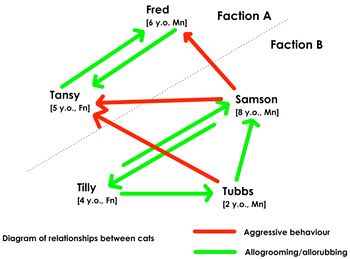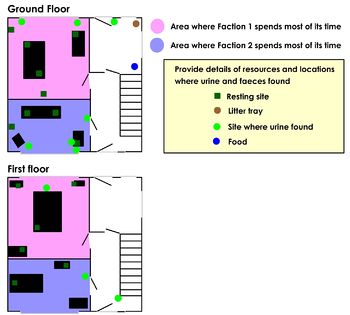Behavioural Consultation and History Taking
Introduction
The majority of behavioural cases presented in veterinary practice are related to normal feline behaviour that is expressed in an inappropriate or undesirable manner. Investigation of feline behavioural cases therefore requires a detailed understanding of the physical and social conditions that underlie the problem.
Physical Health
It is important to be aware that health problems are a common causal or underlying factor in behavioural problems in cats. For example, lower urinary tract disease (FLUTD) and housesoiling and indoor urine marking are commonly linked. A full physical and clinical examination should be completed before any type of behavioural therapy is implemented. Behavioural changes may precede clinical signs, and also persist after an illness is apparently resolved.
The main ways in which health problems can affect behaviour include:
- Altered motivation: Polyphagia and polydipsia (e.g. due to diabetes mellitus or hyperthyroidism) can lead to competition over resources, pain can cause increased defensive behaviour.
- Altered perception or cognition: Decreased awareness of signalling can lead to interaction conflicts (e.g. visual impairment), and cognitive dysfunction can lead to confusion, anxiety and irritability. Focal epilepsy can produce confusion, sensory disturbances and mood changes.
- General response to illness: Inflammatory cytokines activate a pattern of decreased activity, social withdrawal and avoidance that is called sickness behaviour (due to the effect of inflammatory cystokines).
Additionally, high levels of stress can cause alterations in behavioural, physiological and immune responses. Stress-linked alterations in the hypothalamic-pituitary axis may be linked to effects on levels of dopamine, serotonin, noradrenaline and prolactin. In animals, stress is a contributing factor to gastrointestinal disturbances, skin conditions, feline interstitial cystitis as well as compulsive disorders and increased fear responses.
History Taking
Detailed history taking is the most important aspect of reaching a diagnosis in behavioural medicine. This should include information about:
- The problem from the client's perspective and their expectations of treatment.
- Individual cats (origin, development, influential experiences, personality traits, history of sociability with other cats and people, current and past health, current and past drug treatments).
- The physical environment (including resource availability and distribution, opportunities to perform normal behaviour and avoidance and escape responses).
- Important changes; for example the introduction of a cat, arrival of a new baby, house move, building work, or a change of owner employment/health.
- The social environment (relationship with other resident cats, people and other animals).
- The relationship with the owner.
- Methods of treatment already used by the owner (including punishment).
- The owner's level of knowledge of normal feline behaviour.
- Detailed description of specific events (including context, triggering events/stimuli, and the individual's response).
It is also often helpful to place key information onto a timeline, as this can make it easier to visualise the connnection between events in the cat's life.
Prognosis is considerably affected by owner expectation; it may not be possible to achieve complete harmony between a group of cats, but if this is the only acceptable outcome for an owner then the prognosis will be poor.
Historical information and observation may be supplemented with videos or visits to the animals normal environment.
Social Structure within the Home
If more than one cat resides within the same home, it is important to establish their relationship. An interaction, similar to the one in figure 1., can be used to show the pattern of interaction between cats. During the consultation, the clinician questions the owner about a range of affiliative and aggressive behaviours, and annotates the diagram.
- Friendly: e.g. grooming, rubbing against, tail-up greeting
- Aggressive: e.g. chasing, growling, hissing, spitting, fighting
It is possible to have no affiliative behaviour at all between members of a group of cats, or a to find that there is a a cohesive group with single outsider. Factions are also often found to exist with a household. Understanding the social relationships between cats provides a basis for resource distribution, reduce inter-cat conflict and and finding ways to re-integrate the group.
Resource Availability and Distribution
The correct distribution and availability of resources is critical to preventing and treating inter-cat conflict. Information should be collected that enables the clinician to identify sources of stress, such as competition for food.
House Layout
Draw a diagram of the house to show where the cats have food, water, litter trays and cat flaps (similar to the image in figure 2.). Also mark on this where urine or faeces have been found and which cat left them, if relevant. This is particularly important in cases of housesoiling but is useful in other cases too as it helps to establish the appropriate allocation of resources. This layout can be supplemented with images.
Feeding
Food is the resource that is at the centre of most conflict between resident cats.
- Food type (wet, dry etc)
- Access type (ad-lib, meal fed, on demand, simulated foraging)
- Number of locations
The preference is for ad-lib access in more than one location with food being available at all times, ideally using simulated foraging (activity feeding).
Latrine Sites
Cats show strong latrine preferences, and information should be collected to identify any problems with latrine provision:
- Litter type
- Litter depth
- Type of tray (size, covered/uncovered)
- Location (and level of privacy afforded by this location)
- Number of litter trays
- Presence of latrine locations in the garden
The preference is for mineral based, unscented litter filled to a depth of 2-3cm. Faeces should be removed daily, along with significant urine contamination. Separate latrines should be provided for urine and faeces, and the formula generally quoted for the optimum number of trays is 1 per cat plus 1. Latrines should be in locations that offer the cat privacy, and should be well away from feeding and resting areas.
Environmental Quality
Cats need opportunities to perform normal behaviours, and to be able to avoid, or withdraw from, social contact. This means that owners should provide opportunities for play, climbing and resting in the home. The requirement for a stimulating environment is increased if cats do not have outdoor access.
The outdoor environment should provide opportunities to explore, leave scent marks, hide and shelter. It should also provide latrine sites and be planted to provide cover for the cat whilst moving around the garden (shrubs, tree etc). Gardens that encourage insects are also likely to be more stimulating for cats, since insects form part of the cat's diet and are a potential hunting stimulus.
Outdoor Access
- Access level/frequency: none, free access, permissive, on demand, etc.
- Access type: e.g. cat door, window.
- Access security: e.g. insecure cat door, security coded cat door.
The preference is for free access through a secure, coded cat door that does not permit non-resident cats to enter the home. Free access is important to cats, as it enables them to scent mark and avoid contact with other neighbourhood cats with which they may share outdoor space.
More detailed information is then obtained depending on the main problem:
References
- Heath, S. Chapter 5, Common Feline Behavioural Problems – Feline Medicine and Therapeutics. 2004 British Small Animal Veterinary Association.
- Merck Veterinary Manual (10th Edition) - Behaviour. 2011 The Merck Publishing Group.
| This article has been expert reviewed by Jon Bowen BVetMed DipAS(CABC) MRCVS. Date reviewed: September 9, 2014 |
| The creation of this content was made possible by Ceva Santé Animale as part of the feline behaviour project. |
Error in widget FBRecommend: unable to write file /var/www/wikivet.net/extensions/Widgets/compiled_templates/wrt69470fc37a9b04_17809485 Error in widget google+: unable to write file /var/www/wikivet.net/extensions/Widgets/compiled_templates/wrt69470fc3aac518_62191142 Error in widget TwitterTweet: unable to write file /var/www/wikivet.net/extensions/Widgets/compiled_templates/wrt69470fc3d28c67_34461448
|
| WikiVet® Introduction - Help WikiVet - Report a Problem |

